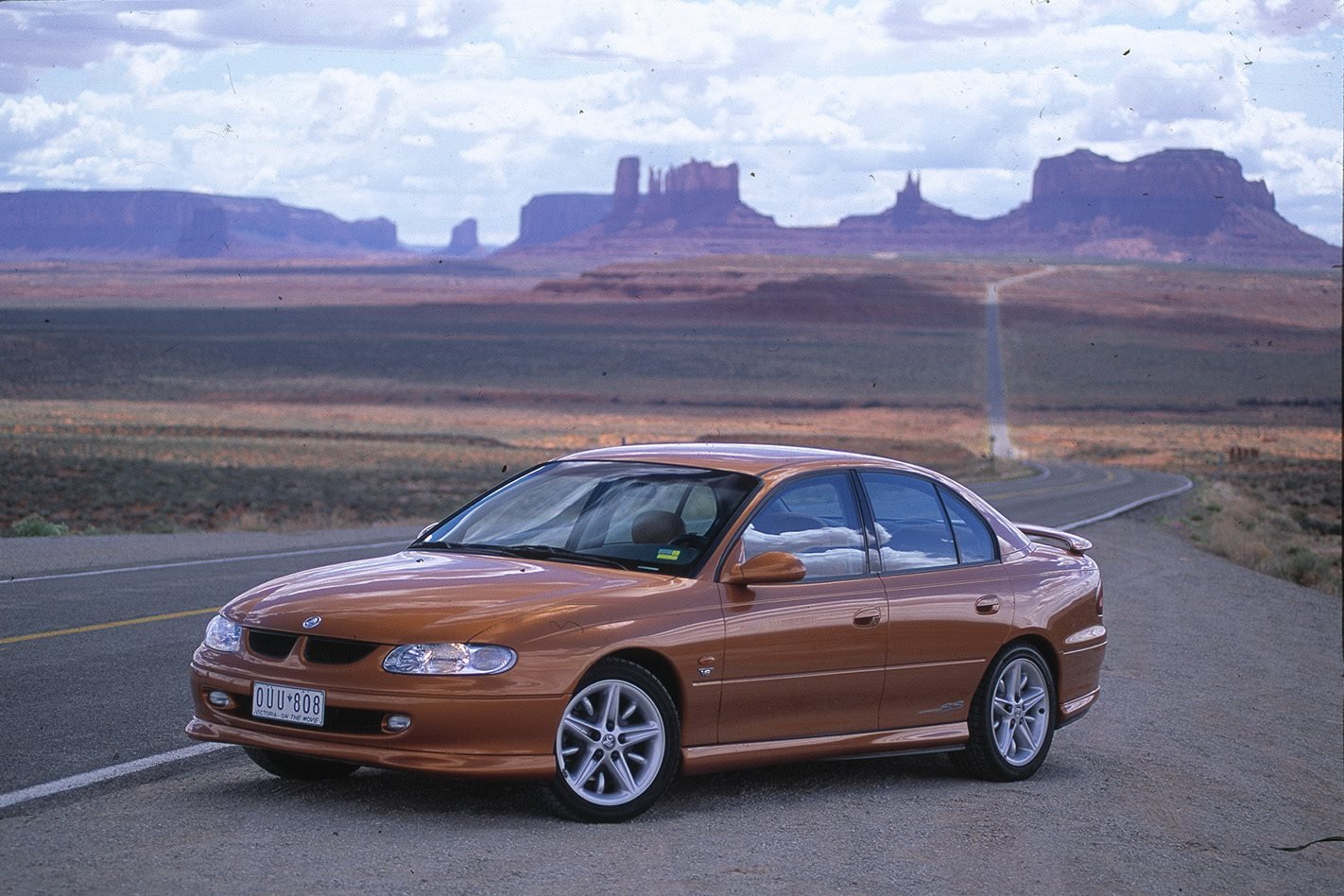A Holden Commodore SS spotted on Rodeo Drive… in the Arizona desert… Monument Valley… Kansas City… cruising Fifth Avenue! What is this? It’s Wheels’ 1998 US tour, as two Sydney staffers give gawking Yanks a tantalising taste of top Aussie iron.
This article was first published in the July, 1998 issue of Wheels magazine
Day One – Los Angeles to Flagstaff, Arizona
Forget Motown – LA is where the car is king. It’s an epicentre of car culture, with everyone from Mercedes to Mercury establishing design studios here to catch the Next Big Trend. If Australia’s Own was going to make an impression in the big wide world, what better place to start.
Now we can’t honestly say the Commodore stopped the traffic, but it slowed and clotted it to an amazing degree. Freeway lane changes became exercises in brinkmanship, as people took pace positions all around the VT, making the move to an exit or even the next lane tricky. But with brother-in-law Mas and sister-in-law Karie aboard there were enough sets of eyes to pick out the smallest opening, usually announced with something like, “Quick, change lanes now – they’ve slowed down to look at the number plate!” The locals must’ve also been thrown by seeing somebody using a turn indicator, too – something not part of LA freeway protocol.
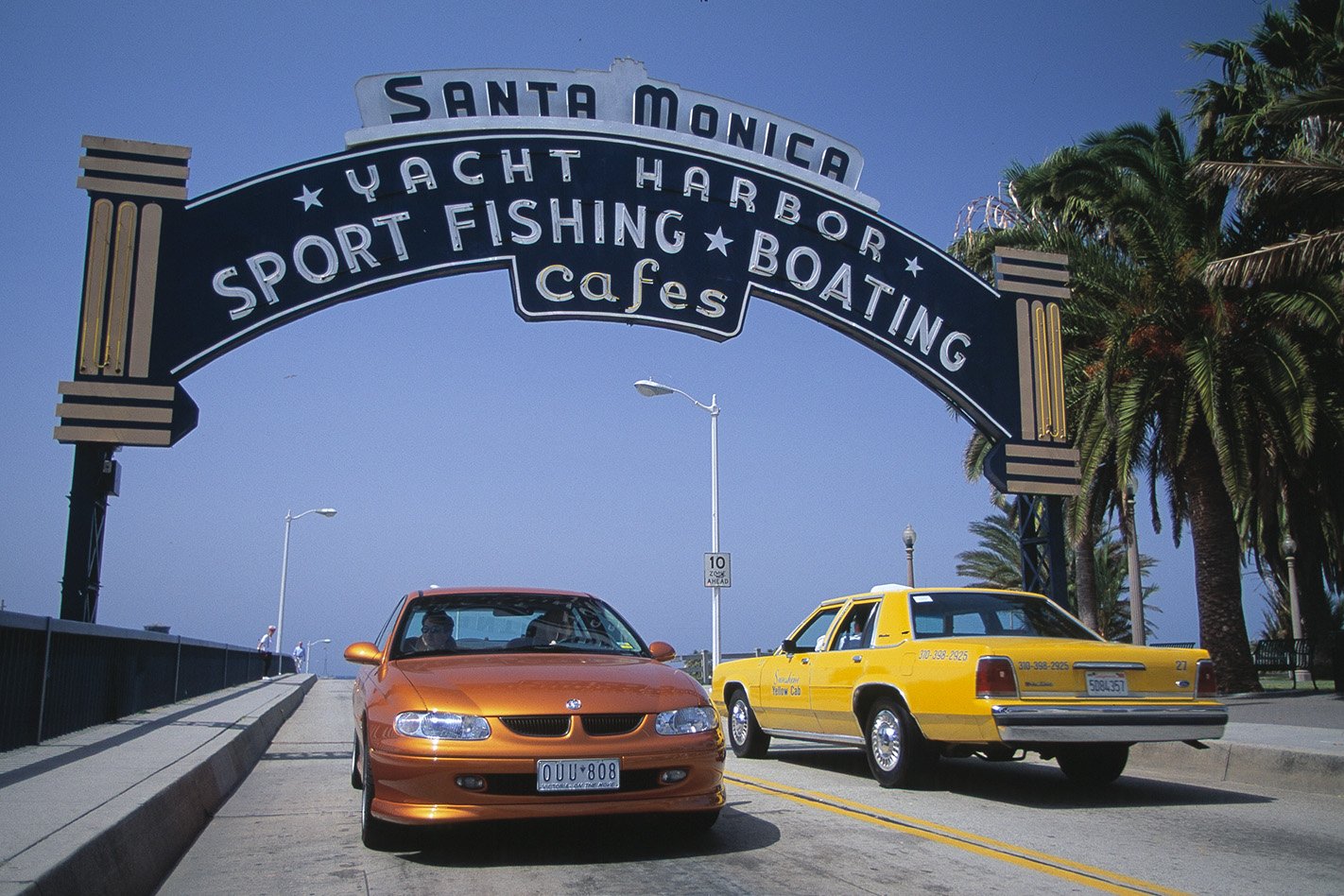
Any day’s a good one to be leaving Los Angeles, but Sunday morning’s an especially good exit time. The weekenders are starting to return to the City of Angels, so the outbound flow isn’t bad at all given the millions of cars on the roads. This weekend we headed out of the San Bernardino freeway to Interstate 15 and thence to Interstate 40 and the trip across the Arizona’s mountainous upper third.
From the top of Cajon Pass, photographer Kent started noticing larger than the usual plague of Harleys you see in the States. Once onto I-15, the numbers went off the scale – we’d pass literally hundreds of the things heading back to LA on the other side of the freeway and would spot similar numbers at servos. Our first petrol stop in Needles, California, at the Arizona border revealed the reason – there had been an annual get-together of Harleyoids in Laughlin, Nevada, with some 50,000 of the things. Obviously not all were started at the same time, as the vibration would have levelled the town.
After a stop at Ford’s desert proving ground outside Kingman, Arizona (a press on the intercom at the remotely gated entrance to ask, “Hey, you got any EA169s in there?” was met by some expletives not heard since school), we headed up the hills to Flagstaff. Surrounded with pine trees and looking more Swiss than southwestern, Flagstaff is a ‘gateway’ to the Grand Canyon and Monument Valley.
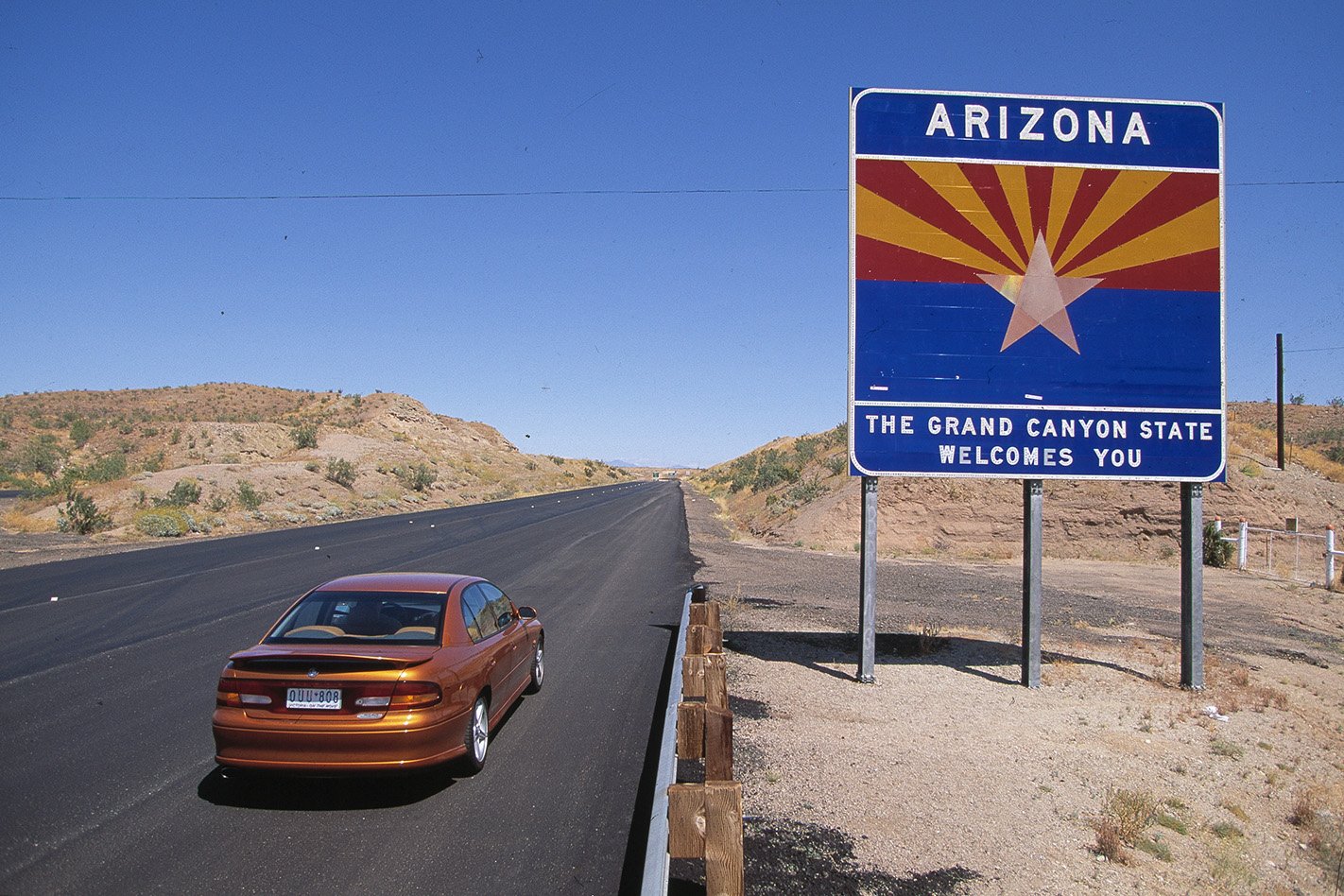
Day Two – Flagstaff, Arizona to Grand Junction, Colorado
It doesn’t take long to drop out of the alpine green of the Arizona highlands into a more traditional image of the American southwest – red-brown desert complete with jutting mesas. Bypassing the Grand Canyon, we head to the north on US 89 to US 180 and thence to US 163 for the drive through Monument Valley.
Seen in squillions of American Westerns (John Ford’s Stagecoach, for one), Monument Valley is as impressive as the big ditch which gets all the publicity a few kilometres to the east-southeast. What’s surprising is that America’s national park service doesn’t administer the valley, but rather it comes under the auspices of the Navajo Nation. We entered what most people refer to as the Navajo Indian Reservation just past Gray Mountain, Arizona, and didn’t realise it till we were passed by a white Ford Expedition with red and blue roof lights flashing and the siren blaring. It looked not that dissimilar to many US police vehicles except for the ‘Navajo Nation Police’ emblems on the door.
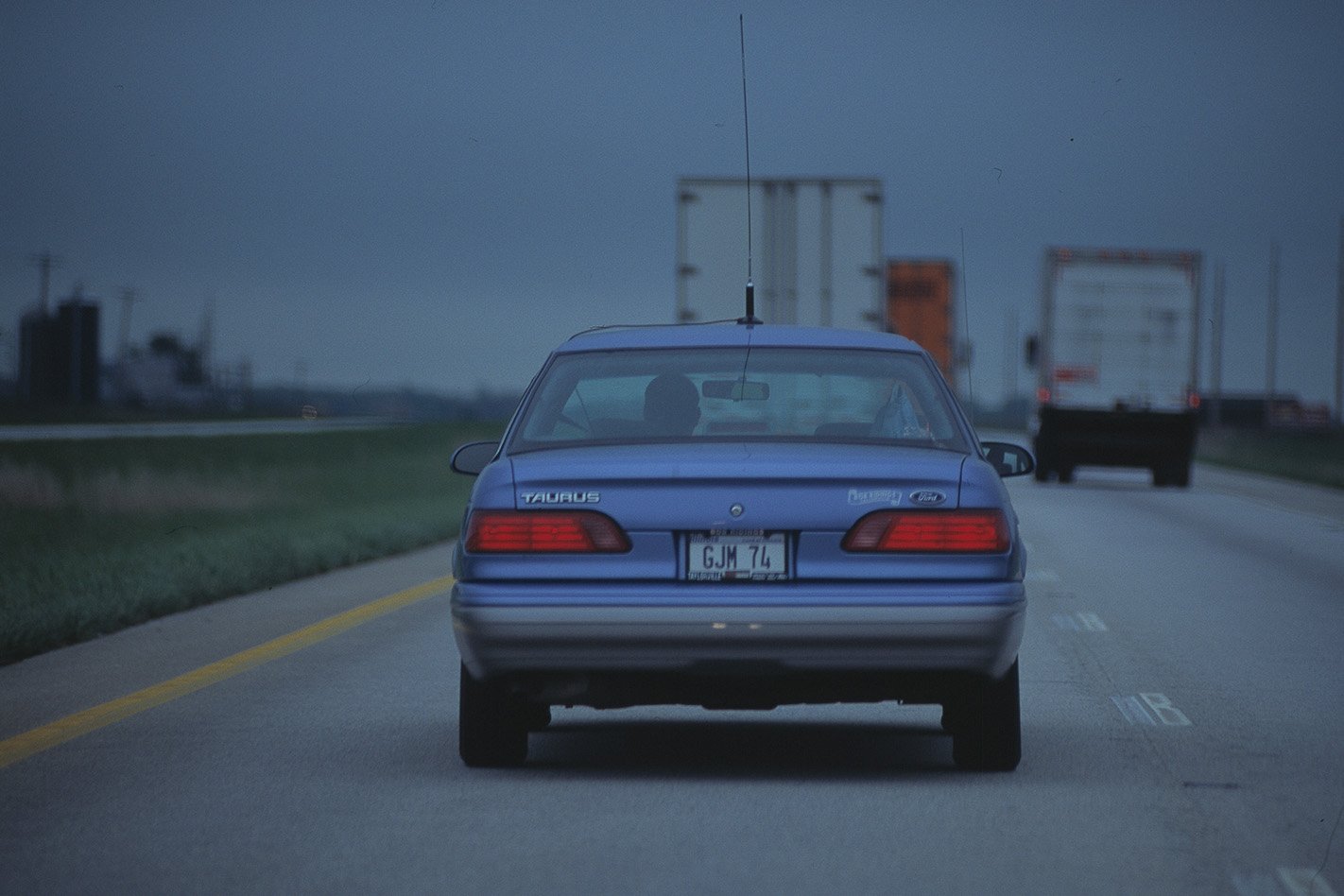
Warwick scopes out a few photo locations in the valley and we spend much of the day ‘commuting’ between them and waiting for the light to improve. It does, eventually, and we continue through Utah up to Interstate 70 and drive East into Colorado. We’re usually cruising at 125 to 130km/ h, but along one level section of I-70 we get passed by a semitrailer going a helluva lot faster. How fast? Well, we gave him a kilometre or so, then tried to close the gap. The speedo crept up to 165km/h and we weren’t closing on him when we crossed the state line into Colorado. We chickened out at about the same time. Getting the VT impounded by the local constabulary wouldn’t go over too well with Editor Angus and the chaps at the Bend, we suspect.
Dinner was at Applebee’s (we had been warned there wasn’t going to be a lot of choice in Grand Junction), where our server spotted the VT through the window in the poorly lit parking lot. This twentysomething young lady was eyeballing the car as we perused the menu till she asked, “Do you know what kind of car that is?” We told her it was a Holden, then queried, “What do you think of it? What sort of car do you think it is?” After a brief pause, she said, “It’s a family car, but it’s not like the sort of family cars you usually see. It’s sportier. Like a (Pontiac) Grand Prix, only better looking,” adding, “I don’t care much for four-doors but I’d buy one of those.”
Maybe there is a market for Holdens in the States.
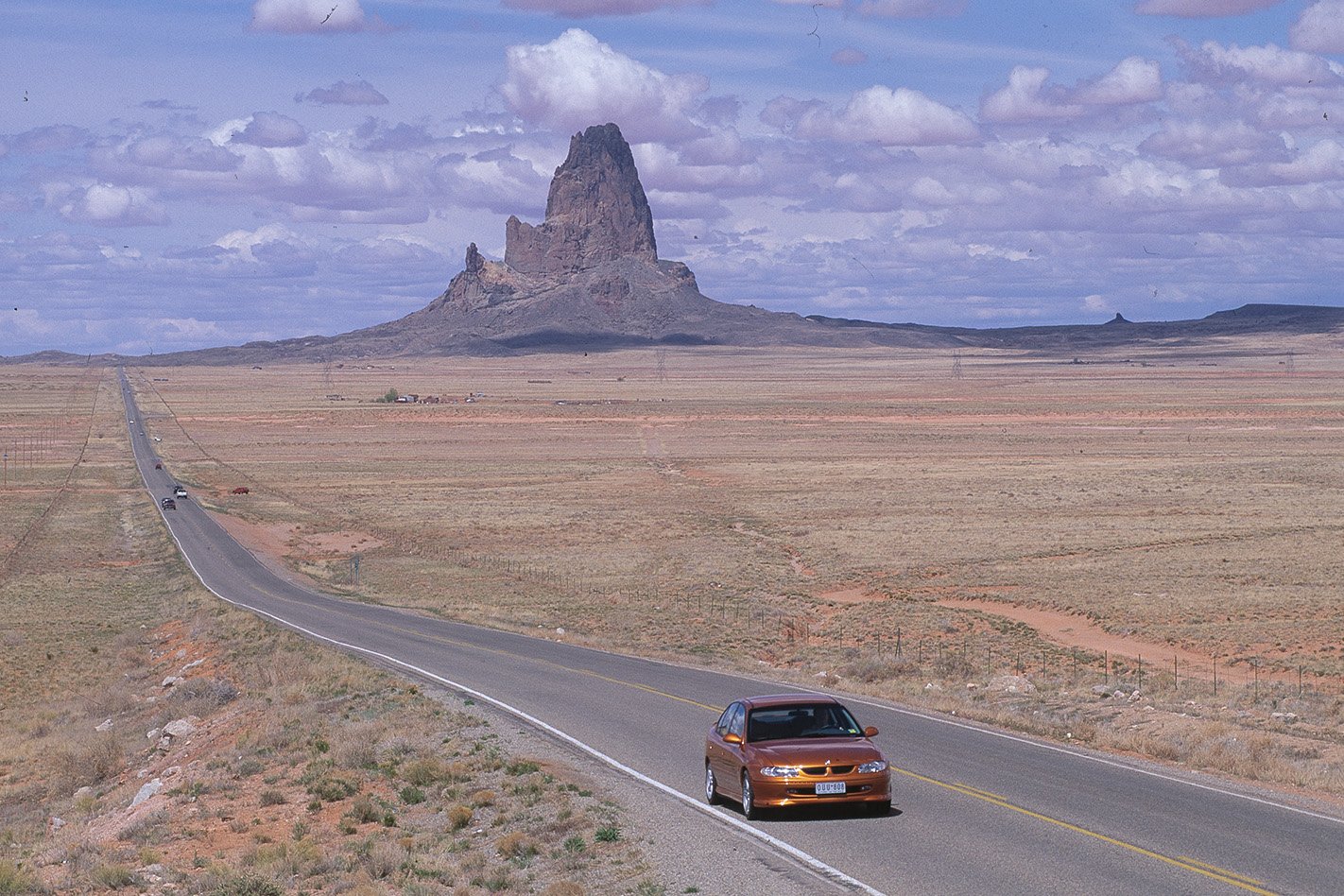
Day Three – Grand Junction, Colorado, to Dodge City, Kansas
There are days when it’s better to stay in bed. The drive out of Grand Junction got off to a good, albeit chilly, start with an early morning bath for the Tiger so it’d look its best in Kent’s pictures. About 8km east of Glenwood Springs at a photo location alongside the Colorado River, we noticed The Sound. It started as an innocuous ‘tic-tic’, but as time went on it started to get louder and rather more ominous. Making our first directional U-tum of the trip, we head back to Glenwood Springs, with the Chevrolet dealer spotted alongside I-70 as our goal.
John Haines Chevrolet was a welcome oasis, of sorts. Given a choice, we’d rather be eating the miles up towards our scheduled stop in Hays, Kansas, nearly 950km east of Grand Junction, but the spectre of something going really wrong with the car in the middle of nowhere was too strong an image to ignore. Pulling into the service bay, we were met by a not unexpected chorus of, “What the hell is that?” Explaining the common lineage between the SS’ supercharged V6 and the one fitted to selected Buicks and Pontiacs, they took a look under the bonnet.
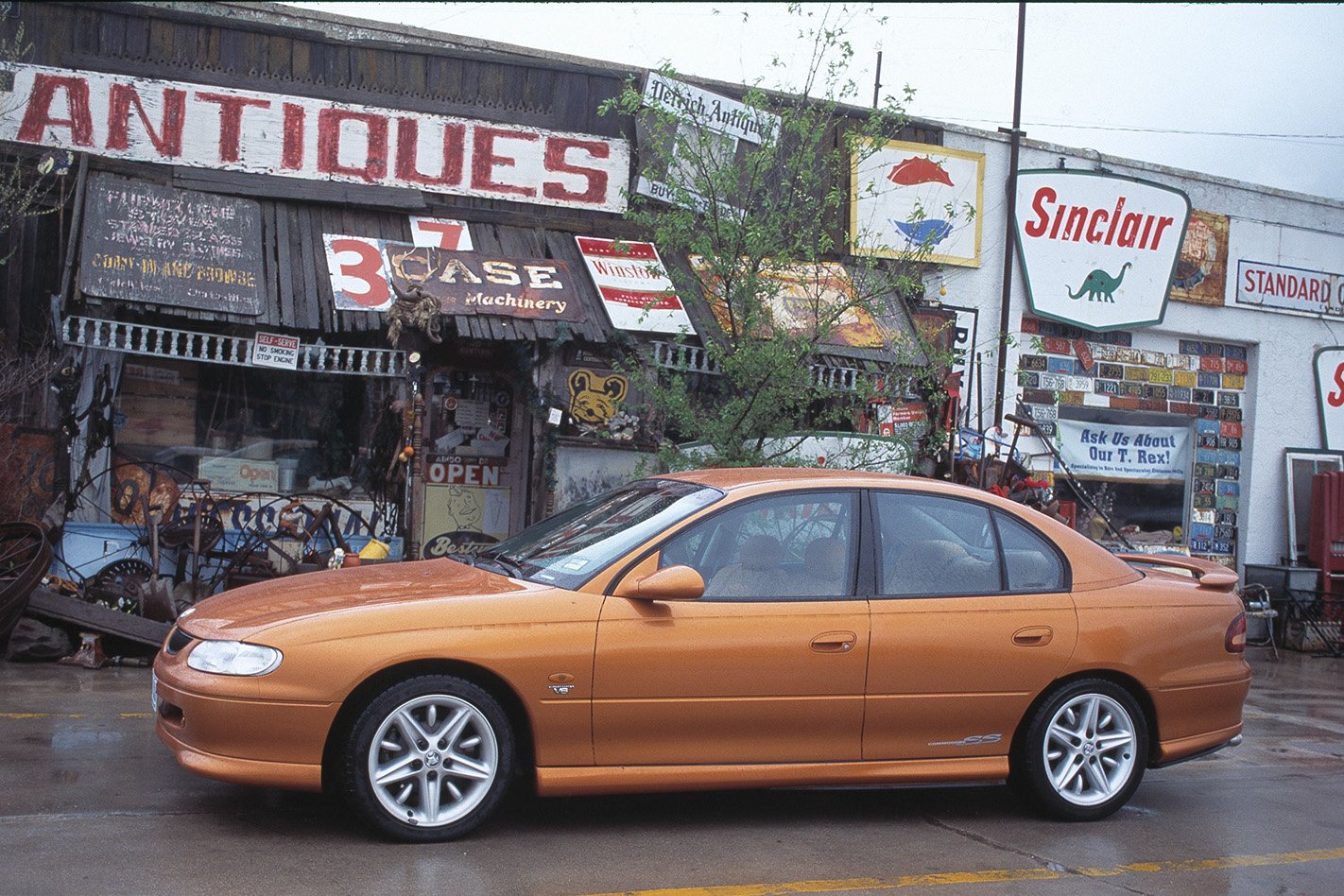
Despite having a boot full of repair parts, the offending pulley idler – the only one shared between the supercharger drive and the accessory drive – wasn’t part of the kit. This Canadian-made part was also the only pulley not shared with the US cars using the engine. Still. the guys managed to quieten the squeaky wheel with a liberal application of silicone grease. A call that evening to the engineers at Fisherman’s Bend describing the sound, problem and rectification indicated that it wasn’t something that would disable the car, though it might get annoying.
Every cloud has a silver lining, and so did our 90-minute pit stop in Glenwood Falls. While the car was being serviced, the workshop’s parts guy ran the Commodore’s VIN through the GM parts computer – and with fascinating results. According to the General’s computer, we were not driving a 1998 Holden Commodore, but a 1999 Chevrolet Lumina.
A couple of hours out of the service bay and we were climbing through the Rockies, heading towards Denver via Vail, one of the States’ sexiest ski resorts. The image boys have been hard at work in Vail, which has vaguely European street and direction signs as well as roundabouts (normally unseen in America), which the locals quaintly refer to as ‘traffic circles’.
Clearing Vail Pass (altitude 3250m) wasn’t the problem for the blown VT as it was for the Subaru alongside us. Even without altitude compensation, the supercharged six was able to perform quite adequately. A zip through the Eisenhower tunnel and we’re on our way in (and out) of Denver. As we approach the Colorado/Kansas border, Kent suggests that we overnight in Dodge City, Kansas.
Stopping to shuffle our hotel bookings as we arrive in Kansas, we manage to get rooms in Marshal Dillon’s home town. Not being a fan of westerns, I don’t feel a lot of excitement about wandering into Boot Hill and the like – but Warwick’s chuffed. He must’ve gone to a lot of John Wayne movies as a kid in PNG.
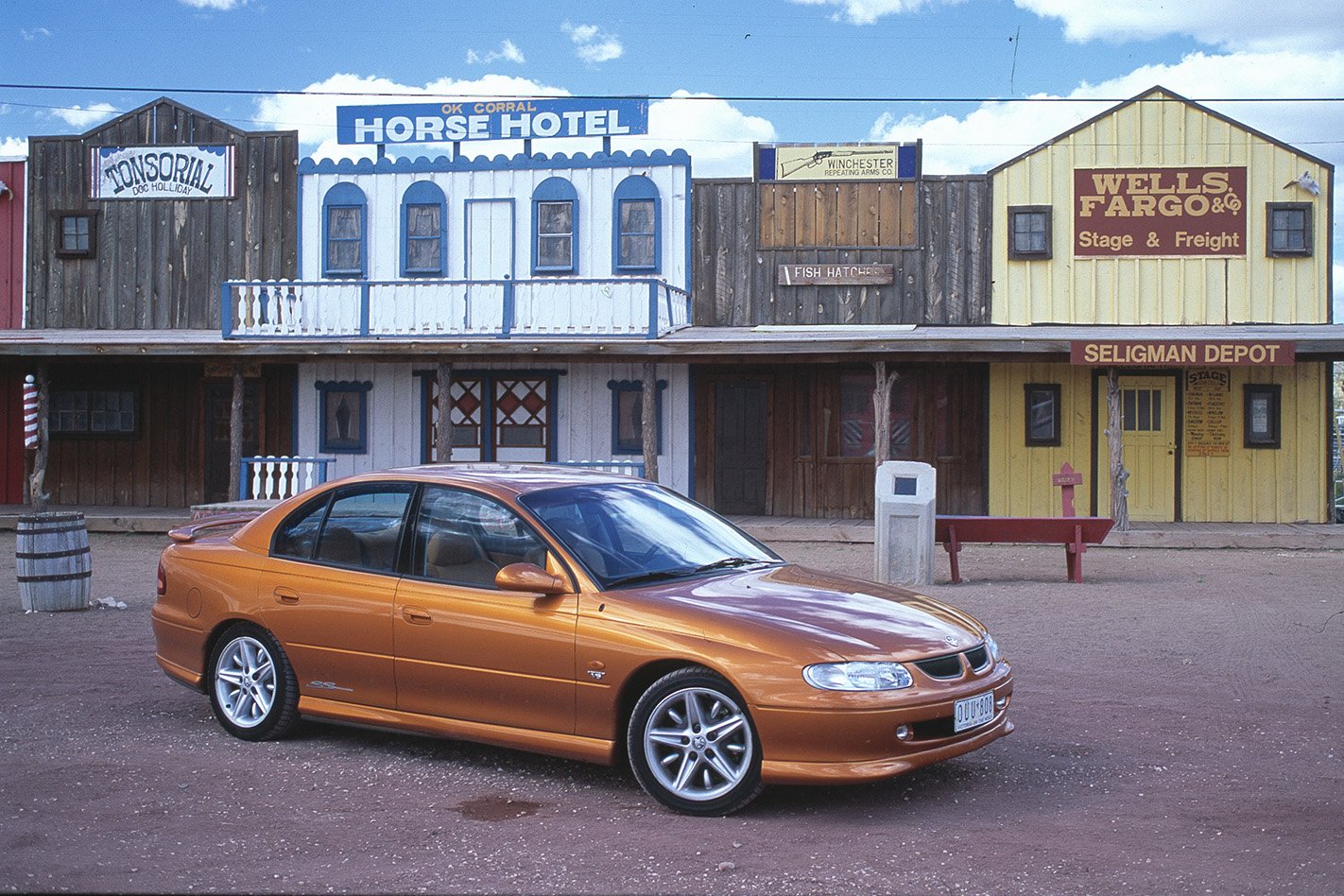
Day Four – Dodge City, Kansas to St Louis, Missouri
Comes the dawn in Dodge City and it’s accompanied by rain. Though we don’t realise it, we’re riding along with a weather front that’s come down from Canada past the Rockies and will continue with us all the way to New York.
Dodge City was a disappointment, and it wasn’t only because of the precipitation. What’s left of Boot Hill is a collection of period buildings moved to a common location, fenced off and out of bounds unless you pay the admission price. Less sterile than Disneyland, to be sure. That left the Dodge City Nitrogen Plant as the town’s other highlight.
Shunning the Interstate for local highways, we head towards Great Bend and thence to the I-70 for a serious drive to St Louis. The deviation from the planned stop at Hays to Dodge City has added about 240km to the expected 850km drive, so it’s gonna be another long day.
Crossing to the Kansas/Missouri border is uneventful. I’m so glad to be making progress, I even forget to tell Warwick, “We’re not in Kansas anymore, Toto,” when we cross the Missouri River into Missouri. A few kays down the road we stop to chat with Dick Carlson, a friend of many years, Lotus fanatic extraordinaire and owner of Age and Treachery Racing, who lives in the ‘real’ Kansas City – the one not in Kansas. After supplying us with bags of Atomic Fire Balls (an aptly named and fearsomely – chilli – hot American lolly) for the Wheels staff, we continue across what Missourians call the ‘ShowMe’ state. It’s well named.
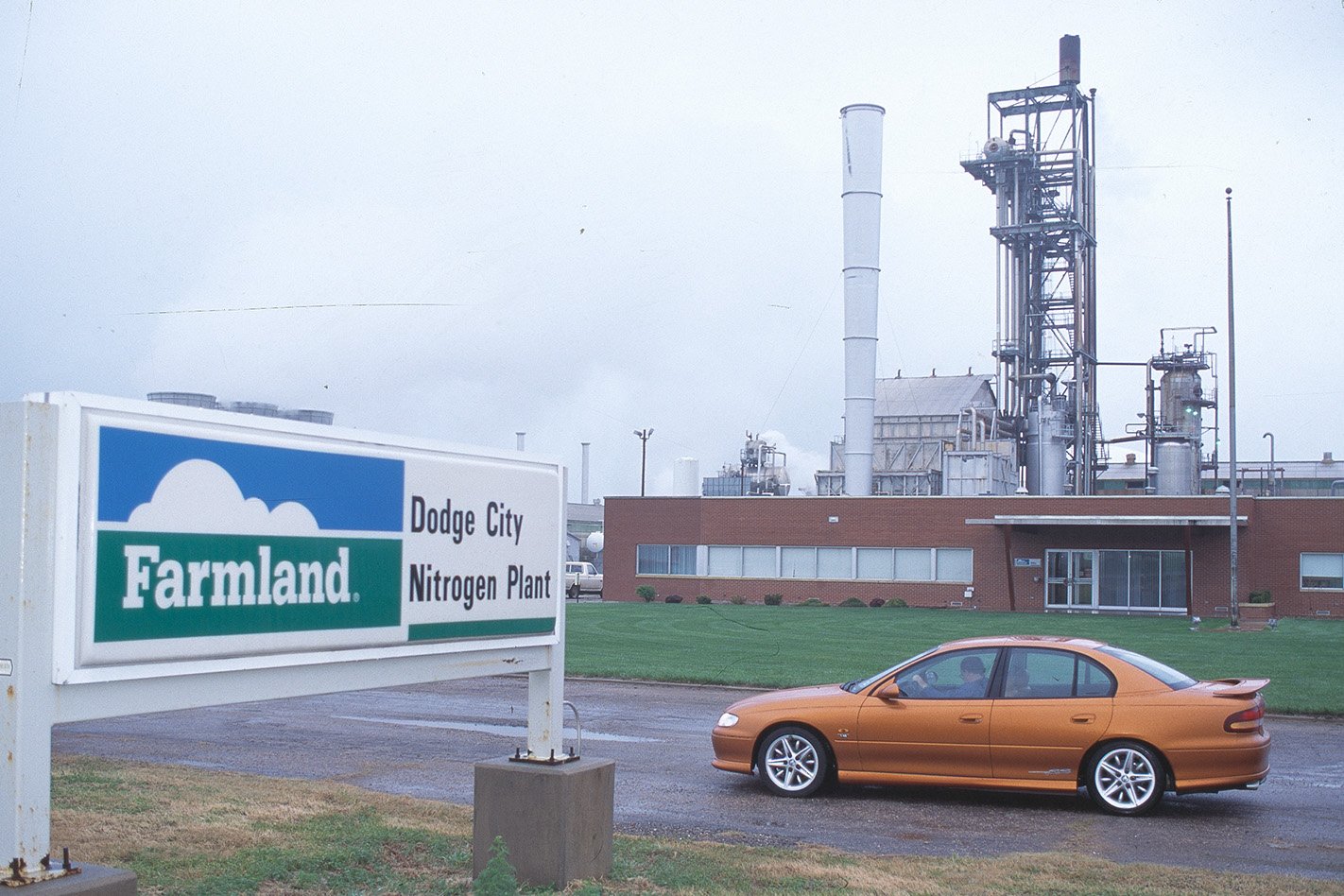
“Show me” is what the locals should say regarding driving lessons. We quickly come to the conclusion that while America has a ton of really bad drivers, the ones in Missouri must be near the bottom of the barrel. The concept of lane discipline is alien to most Yanks, but it must be utterly beyond the comprehension of the folks behind the wheel in Missouri. Aside from protecting the left lane from God knows what, they allow clumps and clots of trucks filling both eastbound traffic lanes which sometimes are nearly 750metres long. Passing? Forget it. When the interstate finally does widen to four (and later six) lanes per side, we’re met by a downfall of near monsoon proportions.
Arrival at the pub in downtown St Louis is like wandering into an Oasis. The rooms are nice (we stayed at the Omni) and they’ve got maybe the best US beer, Boston’s Samuel Adams, in the bar. After the hell drive into town, the beer, plus the knowledge that Illinois is less than 10 minutes from the hotel, provide a miraculous calming effect. And the pulley sound remains notable by its absence.

Day Five & Six – St Louis, Missouri to Detroit, Michigan
After a brief stop to see if the Gateway Arch can’t be polished up a bit better, we head into the Land of Lincoln – Illinois. Compared to the previous day’s drive, this is like venturing into paradise. The folks in Illinois tend to protect the left lane to a far lesser degree than their cousins in the rest of the States so traffic rolls along at a reasonable pace. Even the American propensity for tailgating seems less prevalent here than in other states, too. Plus, the roads and villages of southern Illinois are a picture postcard of America’s heartland. Storybook towns that look like (attractive) movie sets.
Just after we cross the state line into Indiana, we give the Commodore a feed at a Sunoco servo, letting it quaff the 94-octane juice. Because of the manner in which petrol octane is calculated in the States, that nectar was roughly the equivalent of 98.5 octane here in Oz. Of course it was expensive by local standards – all of 53 cents (Australian) a litre!
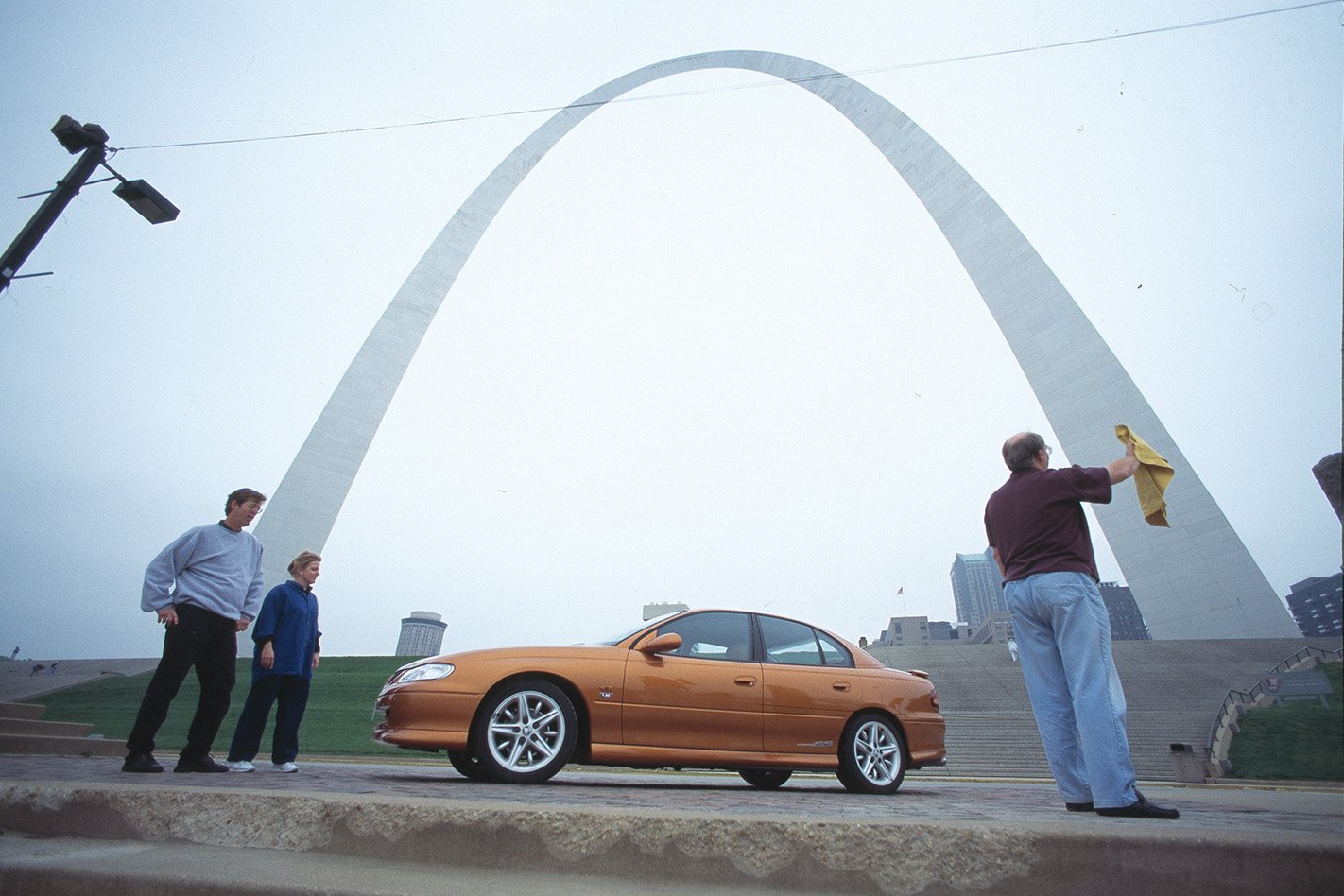
Inasmuch as Indianapolis was between us and Detroit, we sniffed out the home of the self-proclaimed ‘greatest spectacle in racing’, Indy’s beloved brickyard. Despite Chevrolet supplying both pace car (Corvette in really ghastly livery) and driver (well known wheelman Greg Norman) for this year’s IRL, we assumed the Holden/ GM/ Chevrolet connection would probably be too obscure to convince track management to let us do a few laps. Anyway, Neil Crompton should be circulating around the place, not us. But we were spotted by an expat Aussie in the track’s car park who was powerfully confused by the Victorian rego and left-hand drive.
Despite some crook pavement in Colorado’s mountain passes, the roads across eight states had been pretty good. In a few places (Kansas particularly) there was a tendency to close two of the four lanes of an Interstate for miles at a time to allow construction – although there was no construction visible. But then we came to Michigan. Cross the state line into Michigan and you feel it – we couldn’t imagine more appalling roads than the ones around Detroit. Kent realised why US cars have their famous blancmange chassis tuning – the road surfaces demand it or you could be beaten to death.
The freeways in the Detroit area are an amazing festival of potholes and ramps created through a unique combination of frost heave and neglect. At least we have a couple of days in Detroit out shooting in Motown.
When we visited the guys at Automobile Magazine in Ann Arbor, Michigan, we lost count of the folks wandering over to ask questions about the Commodore, including the unanswerable, “Why doesn’t GM sell it here?” After everybody had crawled over, under, around and through the Holden, executive editor Mark Gillies (an ex-pat pom who misses cricket – something that even ESPN2 doesn’t show in America) took us out for some impromptu ‘ramping’. When most of the roads are arrow straight and comers of the 90-degree variety, this oddball car ‘evaluation’ involves continually driving round all the exit ramps at a cloverleaf freeway interchange. This tells you a lot about how a car works in a fast series of hard curves and turns – as long as the turns are right-handed.
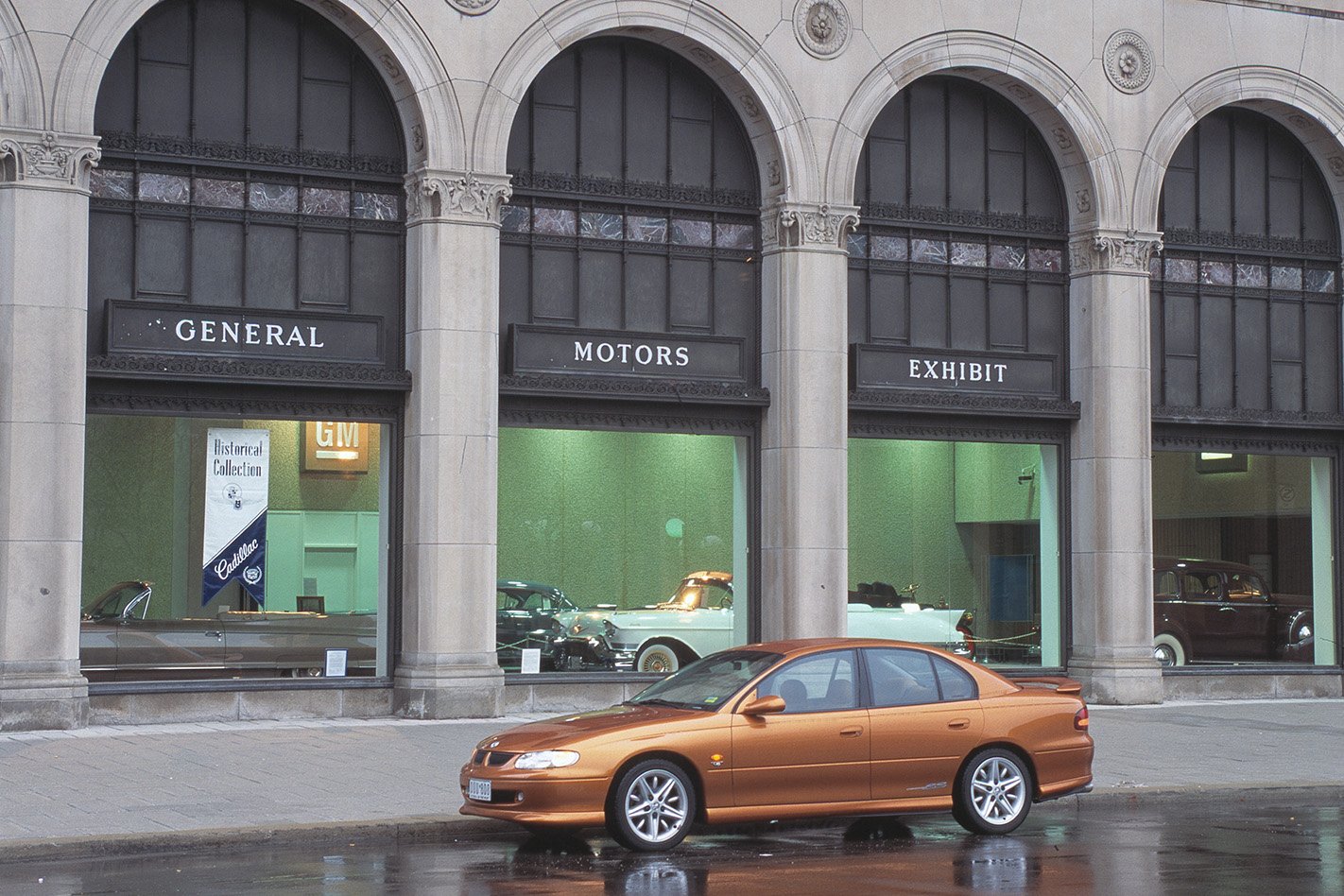
Returning from this fascinating exercise, we get boxed in by a black Chevy Suburban with black-out window tint, making it look even larger than these things usually do. The window slides down on the passenger side and a, er, beefy black chap gives us the eye, takes off the dark glasses and says “Man, that is one bad car. What is it?”.
One of the photo shoots hits a snag. Early Saturday morning (about 6:10), we roll into a parking lot down the street from the old GM headquarters building in Detroit. We find The Spot for the shoot, and before Warwick can even get his tripod out of the car, here comes a dishevelled and especially humourless security guard. No amount of reasoning works with this guy who is so by the book even John Wayne would have decked him. While on his walkie-talkie with ‘headquarters’ (whatever that was) he even takes note of our ‘Canadian’ licence plate.
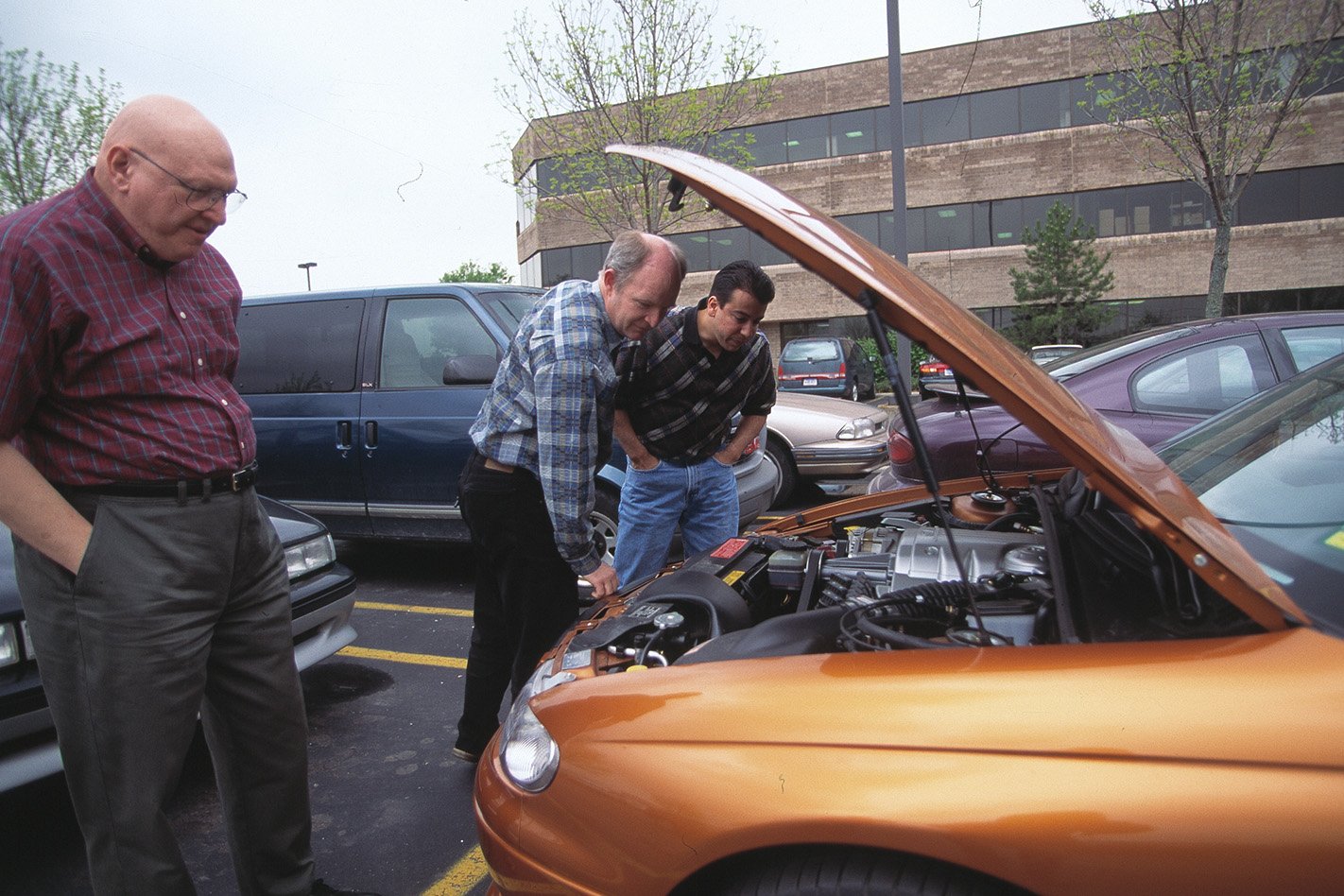
Day Seven – Detroit, Michigan to Youngstown, Ohio
This was the easiest day of the trip, both in planning and execution. We’d allocated a lot of time for the trip across Ohio, so that Wheels’ US man, Chris Jensen, could get some seat time in the Commodore and give us his impressions of it (see bottom of article).
Armed with our ‘Ohio Radar Detector’ (a bag of microwave popcorn on the dashboard- legend has it they use so much radar in the Buckeye State, it will cook the corn for a freshly popped snack as you are being booked), we wander into Cleveland’s leafy and elegant lakeside suburbs to meet Chris and his wife.
Shooting the Holden with Ford’s VS Taurus SHO near Cleveland’s Riverfront Stadium also brought out a swag of security people – these as affable as the bloke in Detroit was not. Once again, there was a high degree of curiosity as to why the Commodore wasn’t included with the rest of GM’s stateside offerings.
Considering Ohio’s reputation for police enforcement is on a par with that you’d be likely to find in Leipzig in, say, October 1943, the Boys In Blue were spotted only twice on the interstates. In both cases their quarry didn’t appear to be eating popcorn. They obviously weren’t as well equipped as we were…
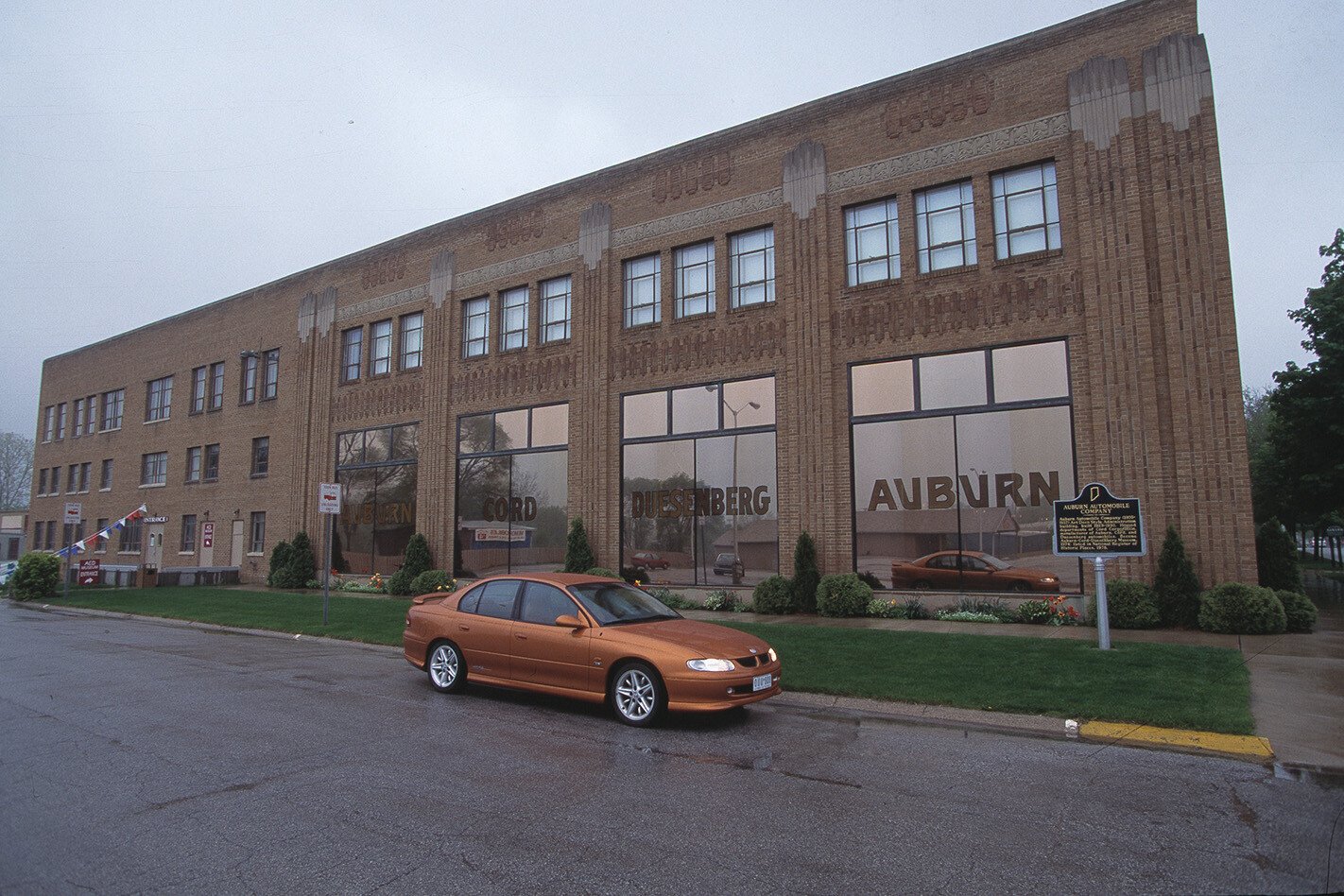
Day Eight – Youngstown, Ohio to New York, New York
We got off to an early start, entering Pennsylvania before 8pm. The Keystone state was the first place we spotted an internet URL on the ‘Welcome to … ‘ sign. Have American cars got internet terminals built into the dash? Hope not.
Breakfast takes place in Grove City, Pennsylvania, at the unimaginatively though aptly named Grove City Diner. Now, normally we wouldn’t get too hot and bothered about brekkie, but the combination of the best morning meal and first really good cup of coffee we’d had in, oh, 6000km, you sort of remember such things. If you ever make it to Grove City or thereabouts, now you know where to get some decent tucker.
Returning to the interstate, we spot a sign to Punxsutawney, ‘Weather Capital of the World’. Now that one’s certain to stir your curiosity. This is where Punxsutawney Phil, the world’s most famous groundhog resides.
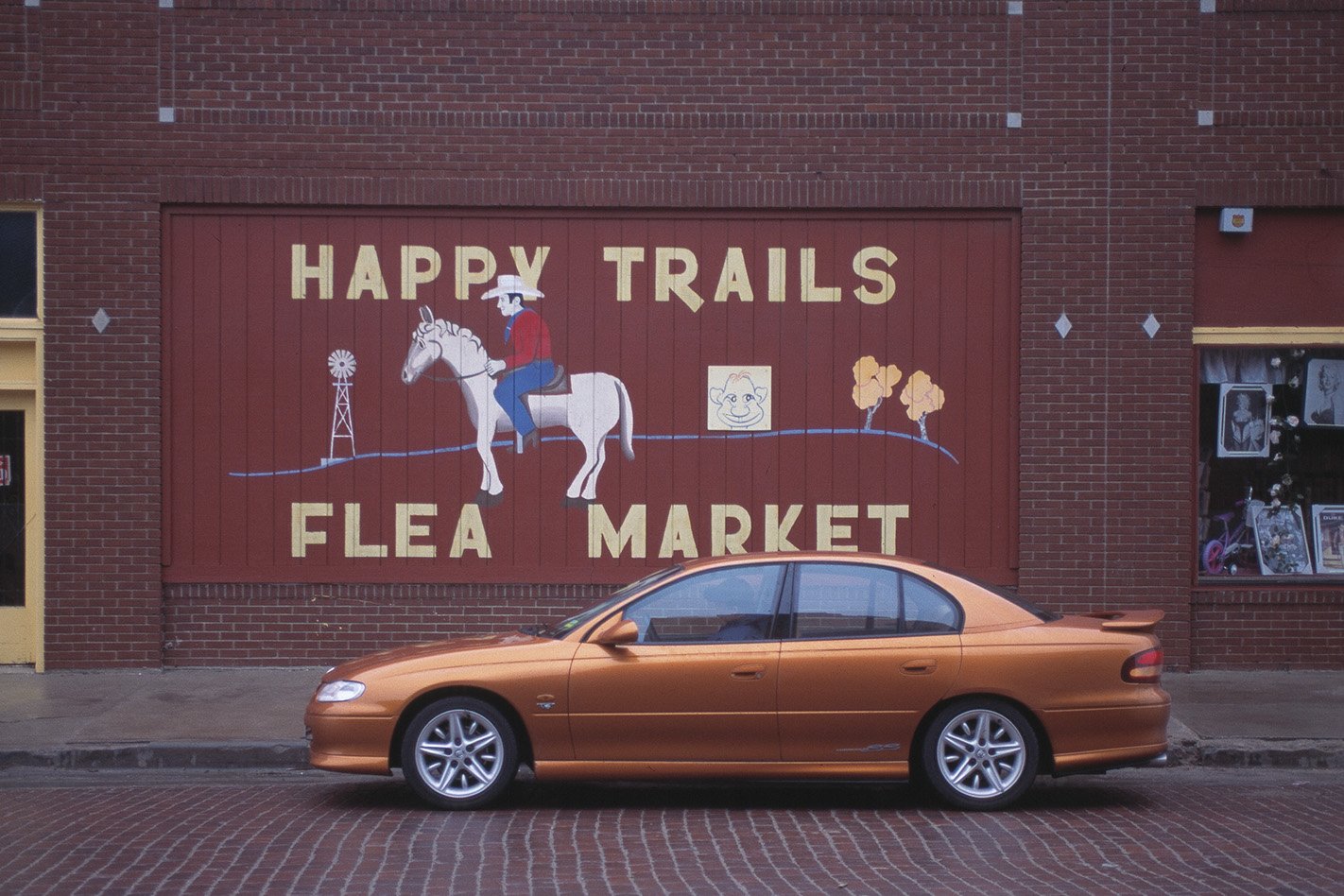
For being the weather capital of planet Earth, the weather was pretty dreary. Maybe Phil’s pissed off, like many of the residents, that the film Groundhog Day was shot in Illinois and Indiana rather than in Punxsutawney and he’s packed off to Parts Unknown, taking the weather with him.
Like in Kansas, there’s a predisposition in Pennsylvania to close off half the lanes of an interstate highway for no visible repairs. In conjunction with speed limits which drop as you move east, you make appreciably fewer miles in a day as you move towards the US right coast.
Neither of us saw a ‘Welcome to New Jersey’ sign when we crossed into America’s ‘Garden State’. What we did notice at our last stop for petrol was that there didn’t seem to be any self-serve servos in New Jersey (and, as we later found out, in New York). It’s a state law, perhaps indicating some sort of dark, pyromaniacal side of many of the residents of Joizy and the rest of the Tri-State area.
Kent is getting really chuffed as we motor along NJ Route 3 towards the Holland Tunnel and New York but, as with Dodge City, I can’t share his enthusiasm. Even though I sat behind the wheel of a Holden for the first time in NYC (an HD Premier at the GM’s 1965 World’s Fair exhibit), it’s a place I can handle for three or maybe four days. And the toll collector at the Holland Tunnel reminded me why. One helluva surly individual.
Pop out of the tunnel and you’re in NYC. The thick of it, as it were. Though there wasn’t a lot of driving between the tunnel and the Plaza Hotel along Central Park South and Fifth Avenue where we were staying, we saw the unimaginable – roads that even were worse than the rough-hewn tracks encountered in the Detroit area. The FE2 suspension combined with the SS’s 17in rubber to provide a package that was all wrong for New York City.
Time to lob into the pub, get checked in then immediately head out for a photo session in Times Square. If you’ve not been to New York in a while, the first thing you’ll notice is how much Times Square has been tidied up. The nightfighters are gone, along with most of the peep shows, so the image of depravity that once was associated with the place has disappeared. It’s a bit of a shocker. Kent even wandered down to the Square to shoot some artsy non-Commodore night-time pics – and walked back. Intact. While there are still some sections of the city that we wouldn’t recommend wandering through at night, the Big Apple seems to have really got its act together.
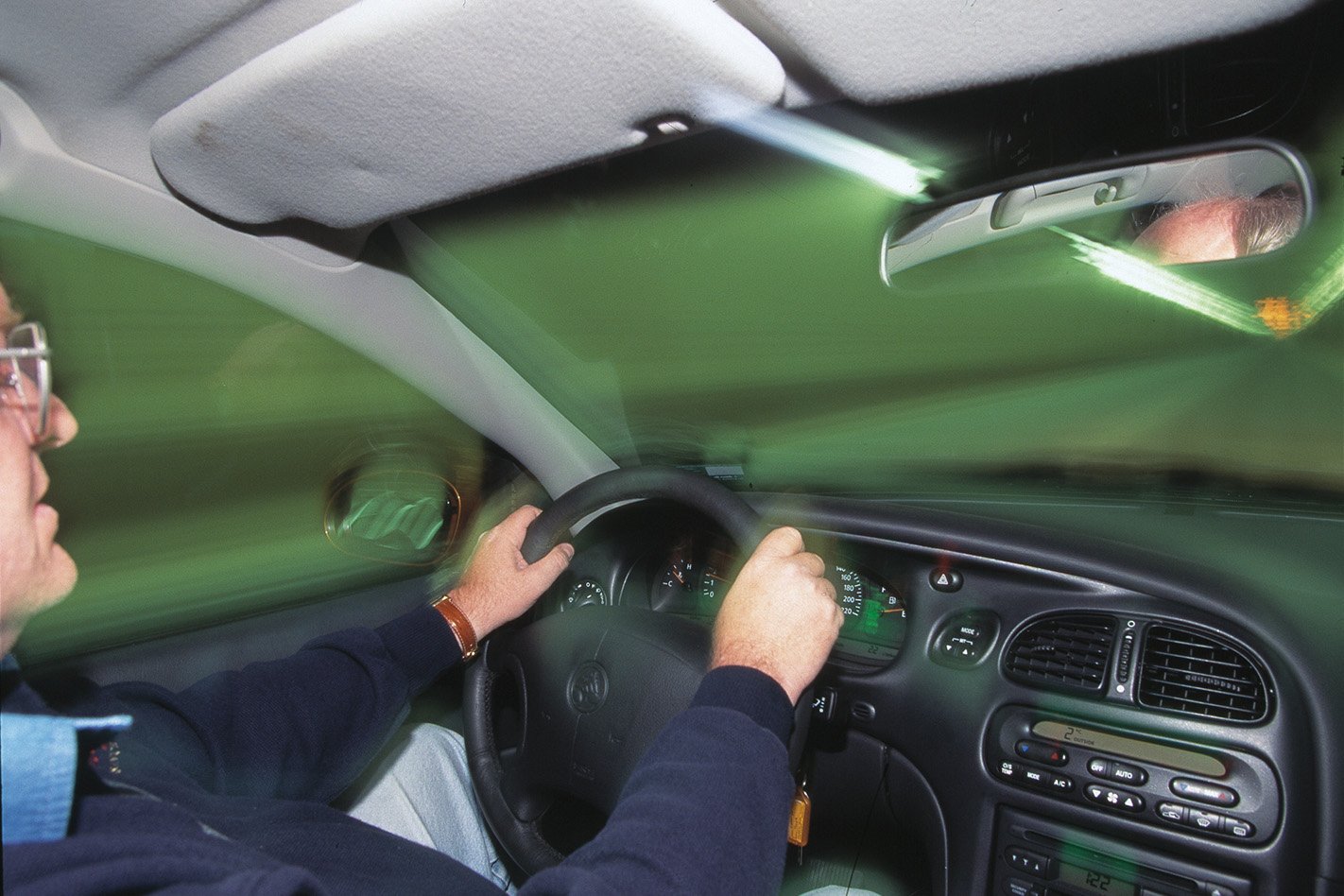
An early (5:30) call for shooting the next morning includes a trip down Fifth Avenue, through lower Manhattan, past Wall Street to the Battery with the grand plan of getting a shot of the car with the Statue of Liberty in the background.
With the removal of most of the piers that were once home to a fleet of transatlantic liners, many of the potential photo locations are gone. In the place of the southernmost ones, is a new development of town houses and high-rise condos known as Battery Park City. Progress.
We wandered back uptown along Park Avenue for more Photo Opportunities, returning along Fifth Avenue’s ‘Museum Mile’, home to most of New York’s history and art museums. A drive through Central Park for more photo ops and we’re back in the pub for a well-earned rest.
The next day, our last in New York, we check out of The Plaza and head down Fifth Avenue again, with Kennedy Airport and the long trip back home to Oz our goal. At the traffic light on 50th street, just across from Rockefeller Center (and Radio City), a bloke wanders to the edge of the footpath and asks Question Number One for the 1134th time – in a Brooklyn accent so thick even The Nanny Fran would have trouble understanding.
“Hey buddy, what kinda car is that?”
“A Holden Commodore.”
“Yeah? From Australia? I’ve never seen one. Man it really looks great! They oughta sell it here.”
The people have spoken.
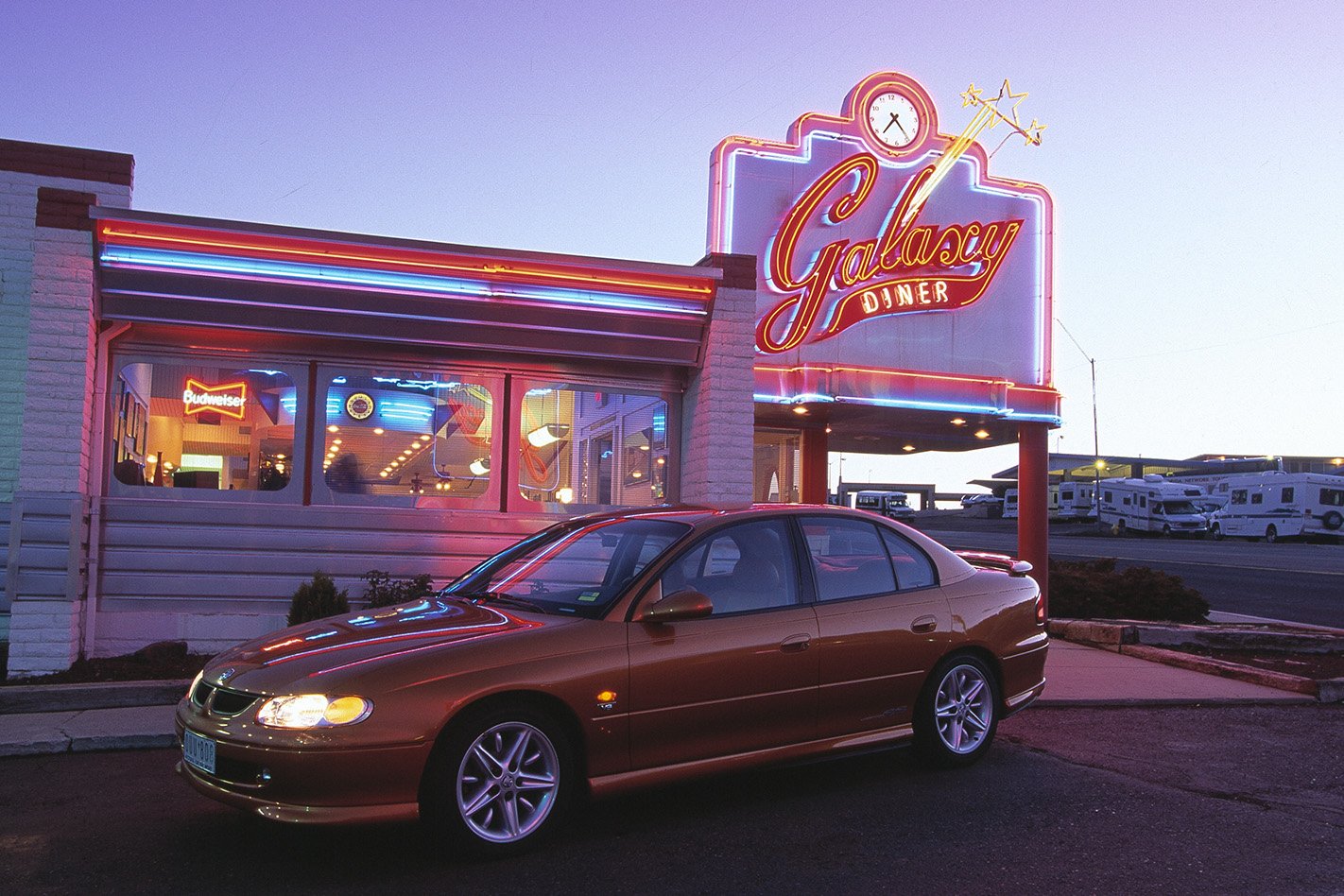
SHO too slow
In Australia it’s the Falcon XR8, but in America the Taurus SHO is the Ford to beat. It’s V8 powered, but can the young bull cut it?
When Ford launched this latest version of the high-performance Taurus SHO, it went to great lengths to describe it as a ‘gentleman’s express’. Perhaps it was to divert attention from the fact this 3.4 litre V8 was slower than the 3.0 litre V6 SHO it replaced. Whatever the reason, the new SHO is notably more refined than the original.
Developed by Yamaha, the 175kW SHO engine is the only 60-degree V8 on Earth. Common logic would imply it was done by merely adding a pair of cylinders to Ford’s Duratec V6 or that it was purpose-built solely for installation transversely. In any case, it provides the SHO with a unique exhaust note and a lope at idle that’s unlike anything we’ve ever heard.
The all-aluminium engine has the requisite twin cams with a quartet of valves per cylinder to generate those 175kW (at 6100rpm), with peak torque of 335Nm coming on stream at 5800rpm. Despite a 4-speed automatic transaxle – no manual is offered – it is a difficult car to drive smoothly in town at low speed. Like pre-VS Commodores, the SHO’s loud pedal comes on with a serious kick from idle. Combine this with generous slop in the torque converter off idle and puttering along in heavy traffic is a tiresome experience.
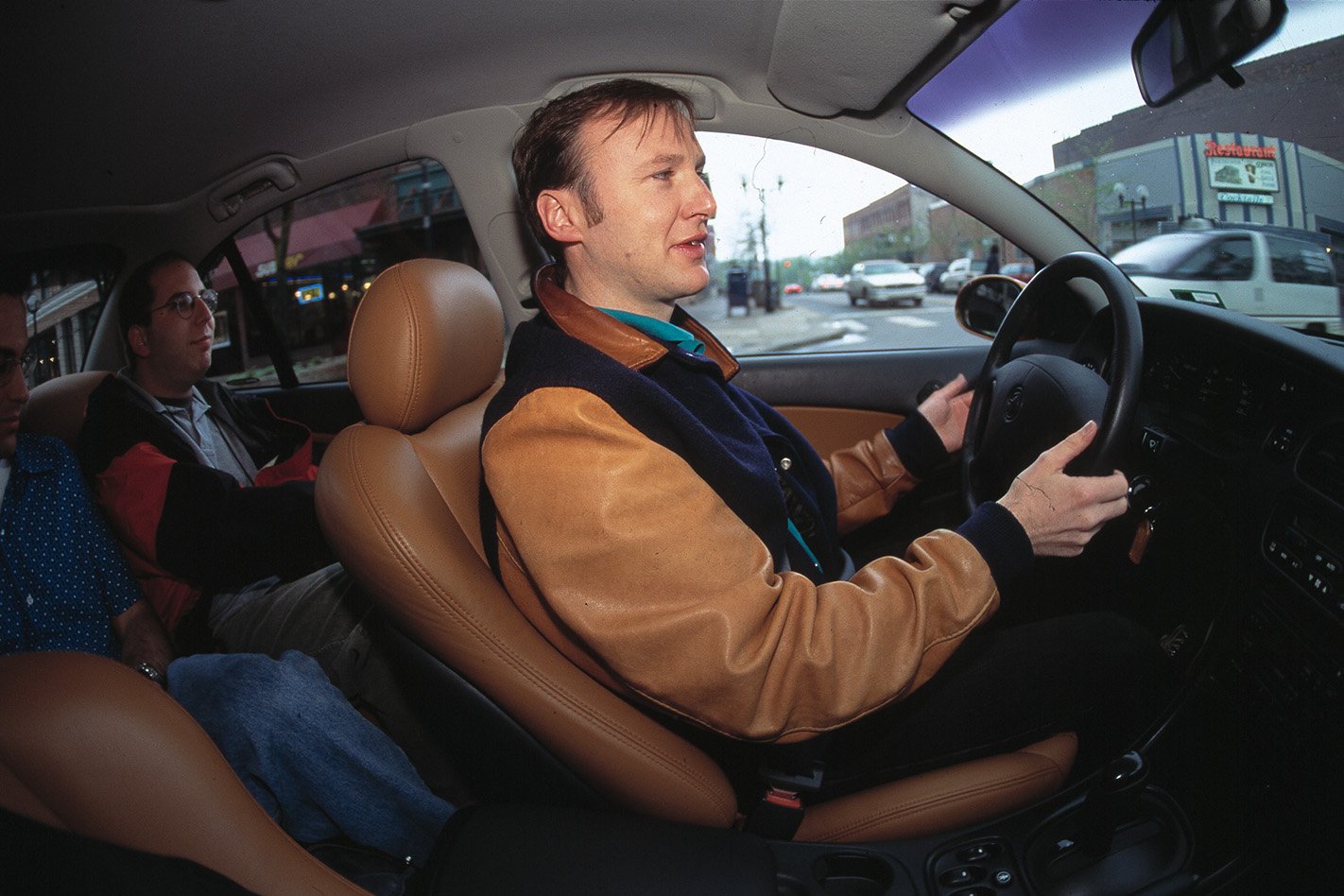
Perhaps because the SHO generates less torque than Pontiac’s Grand Prix GTP, it’s less thrilling to wrestle with when power’s applied. There’s far less scrabbling around from the front wheels when the loud pedal’s given a good jab and the car has fewer engine-induced intrusions into the dynamics than most high-powered front-drive cars. We didn’t have a chance to take numbers, but our man in Cleveland, Chris Jensen, reckons the car’s capable of getting from zero to 60mph (96km/h) in about 8 seconds or a little less. That doesn’t mean that all is sweetness and light, however. In fact we’re sour on the overly light and generally remote steering on the SHO.
So, how does the Commodore stack up by comparison? Here’s how Chris Jensen saw it:
“Here Holden has designed a wonderfully satisfying sedan and GM won’t let it come and play with enthusiasts in the US.
“I’ll take a pass on the SS stitching on the seats, and I guess I’d like it called something other than Commodore. The name brings to mind some incredibly pompous guy from the local yacht club. But those bits aside, I’d buy one in a heartbeat, particularly with the supercharged V6.
“The steering is a triple treat of weighting, accuracy and a level of communication that has eluded GM on any of its other American products, including the Corvette. The Commodore turns in with an obedience that is rare among American cars and while there is a wonderful no-nonsense approach to damping, the ride quality remains good even on the meanest streets of America’s Midwest.
“One could suggest the Cadillac Catera is an alternative. However, anyone making that argument deserves to be whacked around the head. The Catera is a nice package, but is aimed at Caddystyle comfort, while the Commodore is clearly aimed at pleasure. Unfortunately for America it will be a forbidden pleasure. Victoria’s Secret, if you will.”
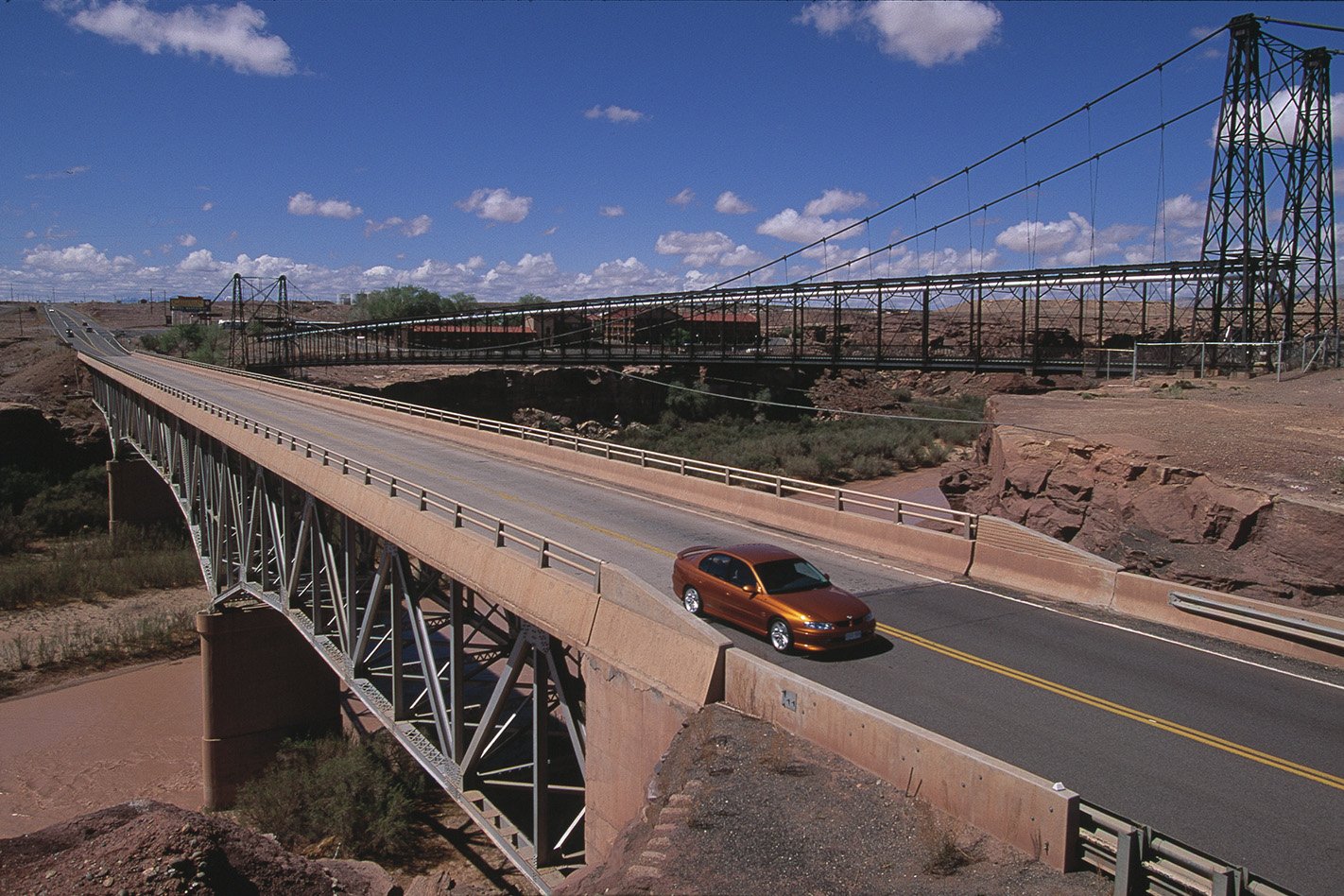
Pontiac Grand Prix GTP vs Holden Commodore SS
If there’s an American version of the supercharged Commodore SS, Pontiac’s Grand Prix GTP would certainly be it – and not merely because both are products of the General’s fertile mind. GM’s ‘excitement’ division takes the same blown 3.8 litre V6 that lives under the Commodore’s bonnet, turns it 90 degrees to drive the front wheels.
The GTP is larger than a Commodore. Overall length is 4991mm (107mm more than VT), width 1847mm (5mm wider), height 1389mm (Commodore’s 61mm taller) and rides on a 2807mm wheelbase – 19mm longer than the Holden. There’s less usable room inside, however – particularly for rear seat passengers. Rear seat headroom is ordinary, and to the rear seat occupants are directly under the rear window. Prepare to fry.
In the Pontiac the supercharged six 179kW at 5200rpm and 408Nm at 3200rpm, while the Holden version pumps out 171kW at the same engine speed and 375Nm at 3000 revs. In practice the difference is inconsequential – despite near-identical kerb weights, the SS proved almost as quick during performance testing in LA by the guys at Road & Track.

We were really curious as to how the punchy six would work in a front driver, so we asked a GM engineer at the company’s Warren, Michigan, technical centre who described it as “a pretty good handler for a hopelessly overpowered and underchassied frontdrive car”. Yes, there’s a certain brutality to the Grand Prix, and it’s called the steering wheel.
Road & Track editor Tom Bryant was just as curious about the Commodore. Here’s what he thought:
“What a pleasure it is to drive a GM sporting sedan with rear wheel drive! You can actually go into a corner, boot the throttle and not have to fight the steering wheel kickback.
“On the road, the Holden has a good bit of performance to offer. The automatic transmission is transparent and does a good job of shifting up and down to match the driver’s input. The ride/handling compromise is quite nice, with a tautness that keeps everything under control during spirited driving. Around town and on the freeway, the ride is supple and nicely damped when going over culverts and bumps.
”The interior styling is quite nice and considerably better than that of the Grand Prix. The dash seems less imposing and not so over-designed. The instrument cluster is quite easy to read and the other gauges are simple and visible. There is plenty of leg and head room in the front, and even the rear seating is pretty good for people of my size. Quality, fit and finish are very nice.
“All in all, the Commodore SS is impressive. It’s a shame GM doesn’t have a car like this in America to replace some of the front wheel drive sedans.”
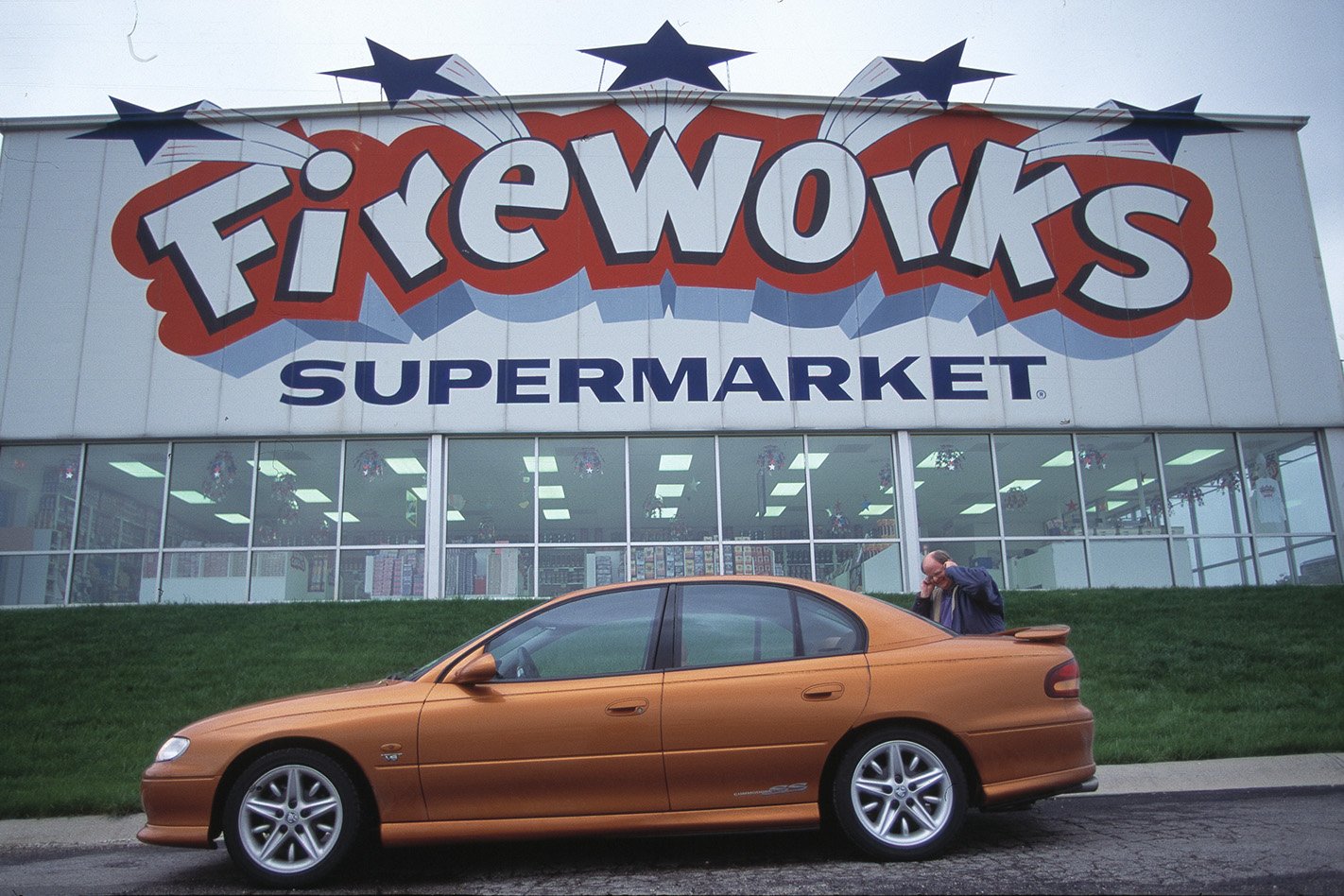
Wheels takes on the world – Part Three
Long-time Wheels readers may be experiencing a sense of deja vu with this story of an Aussie abroad. That’s because this is not the first time we have despatched a hot Holden overseas. Robbo took the HDT-built VL Calais Director to Europe and the United States in 1986. He drove the HSV SV5000 in England in 1990. Our-one-of-a-kind VT SS was built for us by an enthusiastic Holden crew, headed by project engineer, powertrain and chassis, Michael Rochford, engineering program manager Russ Little, senior project engineer, electrical design, Greg Lake, design executive Mike Simcoe, director of engineering and design Tony Hyde and program manager Colin Lewis.

